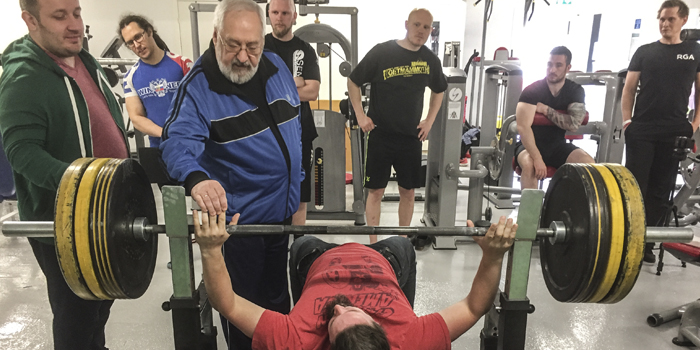
Have you ever wonder how two of the world’s biggest giants in powerlifting can succeed with two methods that are extremely different from each other? Of course, I’m referring to Louie Simmons and Boris Sheiko. I’ve had the opportunity to speak a lot with Boris Sheiko, so I’m going to present his version of how their different system works and how both can achieve such huge success with their athletes despite the training being so different. If you’re not familiar with these men, I can say that Louie’s athletes at Westside Barbell have broken over 140 world records in powerlifting. That can speak for itself! Boris Sheiko, on the other hand, was the head coach of the Russian powerlifting team from 1999 to 2005, which was undefeated in international competition, winning seven European and World Championships with every athlete achieving not less than a bronze. Sheiko has developed nine IPF World Champions who together received 40 gold medals. Sheiko also has become a professor in powerlifting — the only one in Russia and perhaps the world.
Louie’s system is about developing maximum strength, while Shieko's system focuses more on developing the perfect technique. Personally, I think these two systems could do real damage to the old world records together, if combined the right way. The hard part wouldn’t be to learn the exercises, but to learn when to use them and the number of sets and reps you should do. There isn’t any program that suits everyone. Everything must be personalized — even for these two masters of training. But hey, we need to get back to the subject: our interview with Boris Sheiko!
RECENT: Find the Perfect Squat in Five Minutes
We were curious about Boris Sheiko’s thoughts about other training methods when it comes to powerlifting. So, we asked him some questions after the seminar held at Seminoff Sport and Rehab in Hindås in May this year (2018). In many ways, Sheiko's programming looks like the complete opposite of Westside Barbell. So, what does he really think about Westside Barbell and conjugate method? What is the biggest difference between their ways of learning?
Technique vs. Strength
Shieko said that for his way of teaching powerlifting to his students, technique is number one and strength is second. But for Westside Barbell, the raw strength development is number one, and technique comes as number two. Shieko says that Louie Simmons considers strength as the most important key to develop strength and doesn’t pay as much attention to technique. He also says that he had the great pleasure to met Louie in person 2016 and that it was a very interesting meeting.
They spent a whole day together talking about all kinds of stuff, especially training methods. I personally know this meeting with Louie had a big impact on Sheiko, as he has told me about it a number of times. Even last year when he was here to visit me for another seminar, we went out to have a beer the night before and talked a lot about their meeting and how you could try to combine his system with Louie Simmons' system in Westside Barbell. They are both two giants in powerlifting and have succeeded with a lot of athletes — even though they use two systems that are very different from each other. At the same time, success rings on both doors. They achieved the same goal: to get their athletes stronger.
Combining the Methods
We asked Sheiko if it was possible to combine these two methods. Sheiko answered that of course, it’s impossible to completely combine two different methods. And I understand what he means. It’s like combining two languages: you can speak it and understand it, but it’s now a third language. He also said that he finds some of Louie’s methods interesting and decided to incorporate it in his own system. But to go back to my example before: to incorporate some exercises or some few ideas to another system is like borrowing words from a different language. It’s like we use the word "jeans" in almost the entire non-English speaking world except Iceland, I believe. That doesn’t mean we speak English in all countries except Iceland.
Sheiko says he has incorporated reverse hypers, for example, and started to use chains and bands in some lifts, inspired from the conjugate method (which originally came from Russian weightlifters from the Dynamo Club). I also gave him a set of bands—since we produce our own bands—for him to use with his athletes the coming year, so I will have more to add to this content next year.
Box Squats
Another question about Westside Barbell versus Sheiko is box squats. Louie Simmons suggest that you should sit back (back, back, back) and relax before you lean forward to stand up again. Sheiko's box squats are different. He suggests his athletes sit down as a regular squat and then when they touch the box, they should stand up again. I also had a Westside seminar together with Simon Kankkonen from Finland before and talked a lot about box squat, so this question with Sheiko is something I know people wonder a lot about.
WATCH: Training After Westside
Sheiko answered that in Louie’s box squat, the purpose is to build as much strength as possible with the movement. To do that you have to sit far back, keep your knees from going forward further than your foot, and keep your foot further forward than a regular squat. But in Sheiko's box squat, the box should only work as a marker, so you learn how deep you should go and get a better sense for how it should feel. In the most cases, Sheiko's box is much lower than Louie's, since Sheiko wants his athletes to squat a little bit under competition depth. But it can depend, of course, on if there are some different needs for the athletes who perform them. In Louie’s box squat they use it to squat to the depth they need to do for competition, but since they use the conjugate system, they don’t use the same depth all time. In Louie's box squat, the purpose is to build more back muscles and hamstrings. Sheiko's squats are—I say it again—to increase the technique first and foremost.
Squat Stance
Another question Mathias brought up was the squat stance. How should you know how to place your feet and hold your hips? I know about this question myself, but as always, talking to other people allows you to hear things you've never thought of yourself. Sheiko said that the start position plays a huge role in both powerlifting and weightlifting. He said that the way you perform a lift depends on your start position, in this case, the squat stance. It’s really obvious. I have heard many people who say their squats feel like shit for the first few reps, but when they get warm it feels a little better. They usually think this is because they're too stiff, but as Sheiko said, if you don’t feel comfortable in the start position you can’t perform a good lift. Pretty easy, right?
Plyometrics
What does he think about plyometrics? Is it necessary or a waste of time? Sheiko answered that plyometrics were suggested by the Russian scientist Yury Verkhoshansky in 1966. In Russia, they use plyometrics quite often in powerlifting to strengthen joints and muscles. It also trains you to get a better bounce in the bottom of the squat and gets you stronger in the start position for deadlift, possibly since it gives you pressure around the hip and core muscles you have to maintain when you land and aim to jump off again. This is the same muscle function you use in the lifts we discussed above.
Training Session Duration
Many people prompted me to ask Sheiko why, in his program, training sessions are often longer than two hours in duration. He answered the in Russia they consider two to two and a half hours for a training session to be quite normal. In order to master the technique and develop strength, this is needed. He also said that his programs are made for competitive lifters and the competitions often take more than three hours, so they need to get used to performing over a long period of time. That sounds like an important message, and he also said that we could change that part of my program — but then it wouldn’t be my program anymore! I get the point.
On the other hand, though, if you want to build muscle volume and develop more raw strength, you could split the long training sessions into two parts — one with the main exercises and the other with GPP and assistance work. If your athletes can rest between the sessions they may be able to work harder in each exercise and will develop more physically than if all performed in one session. At the same time, the athlete gets used to training for only one hour, while competitions usually take three to four hours or even longer. This could lead to the athlete getting tired of waiting and performing over a long period of time. So in Shieko's mind, with his strategy, it’s better to keep the athlete used to longer training sessions to be more prepared for competition.
Linear Periodization
We also asked him about the linear periodization that is very popular in some powerlifting associations. He doesn't like this approach at all since the method suggest that you train with heavy weights too often and for too long periods of time. His athletes who tried it became over-trained very fast. If you get over-trained, you must rest and then you can’t train, which means you got weaker.
The Interview
I hope this information helped you understand how to make an effective program that suits you. Here are several things to take away from this interview:
- You should realize that strength and technique aren't the same things, but they do work together to develop power.
- Power is the force that muscles produce, along with acceleration. Each muscle in itself can’t do much to the bar.
- If you need to develop raw strength, limit your training session to 45 to 60 minutes.
- Do you need to improve your technique more than you need to develop strength? If so, extend the time you’re spending under the bar.
- Stop trying to find the right answer about how you should plan your training program and search instead for the right questions. What do you need for developing strength?
Stefan Waltersson is a professional strength coach certified by Westside Barbell, lecturer, physiotherapist, author, personal trainer, kinesiologist, sports massage therapist, nurse assistant and founder of Seminoff Sport & Rehab in 2004. Stefan has previously worked in neurology (Sahlgrenska University Hospital) and with researching doctors in microbiology and clinical chemistry. Check out his website: http://seminoff.se/.











There simply isn't a comparison between the two.
https://www.elitefts.com/coaching-logs/westside-only-works-for-geared-lifters-right/
I've been starting to use jump variations for my own training in order to progress back into Shock Plyo training again so I'm going to keep these concepts in mind in the future.
Thanks for sharing!
Louie uses what HE CALLS "the conjugate METHOD" (really, it's the "Complex Parallel Method"! CONJUGATE SEQUENCE is totally different I agree.